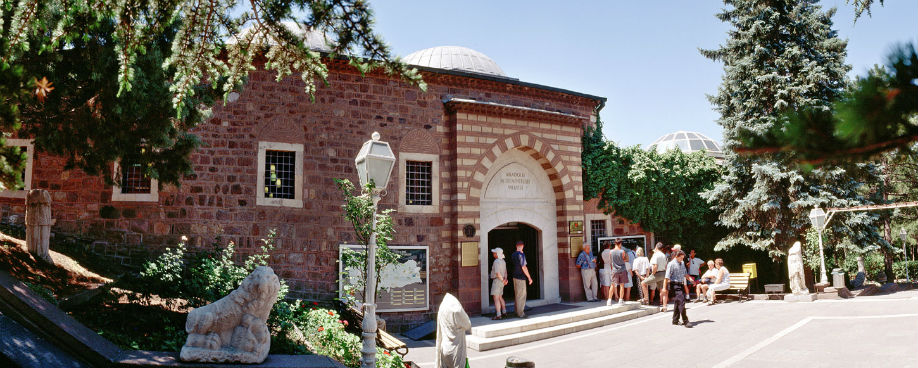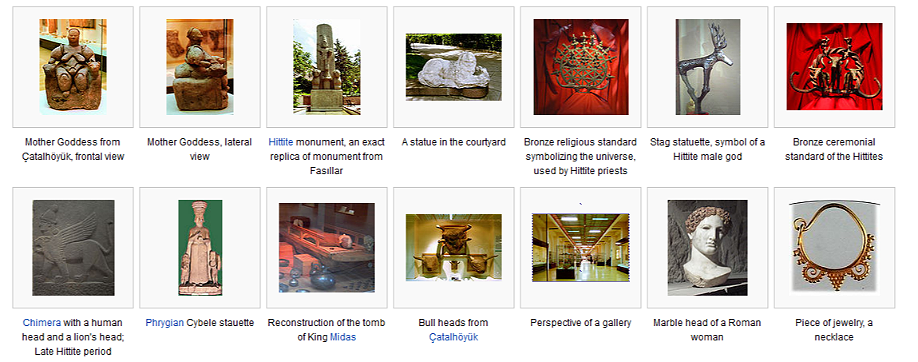The superb Museum of Anatolian Civilisations is the perfect introduction to the complex weave of Turkey’s ancient past, housing artefacts cherry-picked from just about every significant archaeological site in Anatolia.
The museum is housed in a beautifully restored 15th-century bedesten (covered market). The 10-domed central marketplace houses reliefs and statues, while the surrounding hall displays exhibits from the earlier Anatolian civilisations: Palaeolithic, Neolithic, Chalcolithic, Bronze Age, Assyrian, Hittite, Phrygian, Urartian and Lydian. The downstairs sections hold classical Greek and Roman artefacts and a display on Ankara’s history. Get there early to avoid the flood of tour groups and school parties.
The exhibits are chronologically arranged in a spiral: start at the Palaeolithic and Neolithic displays in the room to the right of the entrance, then continue in an anticlockwise direction, visiting the central room last.
Items from one of the most important Neolithic sites in the world Çatalhöyük, southeast of Konya – are displayed here. There’s a mock-up of the inside of a dwelling typical of those uncovered at the site, one of the most famous mother goddess sculptures unearthed from the excavations and wall paintings of hunting scenes.
Also on show are many finds from the Assyrian trading colony Kültepe, one of the world’s oldest and wealthiest bazaars. These include baked-clay tablets found at the site, which dates to the beginning of the 2nd millenium BC.
One of the striking Hittite figures of bulls and stags in the next room used to be the emblem of Ankara. The Hittites were known for their relief work, and some mighty slabs representing the best pieces found in the country, generally from around Hattuşa, are on display in the museum’s central room.
Most of the finds from the Phrygian capital Gordion, including incredible inlaid wooden furniture, are on display in the museum’s last rooms. The exhibits also include limestone blocks with still-indecipherable inscriptions resembling the Greek alphabet, and lion- and ram-head ritual vessels that show the high quality of Phrygian metalwork.
Urartian artifacts are also on display here. Spurred by rich metal deposits, the Urartians were Anatolia’s foremost metalworkers, as the knives, horse-bit, votive plates and shields on display demonstrate. There are also terracotta figures of gods in human form, some revealing their divine powers by growing scorpion tails, and neo-Hittite artefacts.
Downstairs, classical-period finds and regional history displays provide a local picture. Excavations have unearthed a Roman road near the Column of Julian, and Ankara has its own ‘missing link’, the 9.8-million-year-old Ankarapithecus (a 30kg, fruit-eating primate).




A part of it is closed now, still lot of interesting classical museum-items on display. once you climbed up to find the venue, it worth it to spend some time there and lear about the local history.
An incredible look into Turkey and surrounding area's past: The Bronze Ages sculptures were sublime. Pre historic clay figurines are amazing. Absolutely fascinating!!!!!!!!!!
Ankara, One of the best cities of the world and traces back to 15th century. There are lots of old relics, museums and places which are very nicely taken care off.
It has # of museums in it, of which I liked Anatolian civilizations Museum the most and am sharing here with you. If you are interested in history and…
The museum although not very large, has a rich collection dating back to the Hitite period – definitely worth visiting.
Once you get there, the museum is half way between Ulus and the citadelle, you can lose yourself into anatolian history from all periods of time. They have amazing artifacts and you can easily spent half a day there. With good weather don't forget to explore the outdoor area, which is also worth an hour. Nevertheless: the museum is NOT…
The building itself is beautiful and interesting, and the exhibits are extraordinary. I have visited this museum many times. The artifacts from the history of Anatolia, such as from Catal Hoyuk or Hittite sites, are unusual and fascinating. For me, this museum is the most interesting thing to see in Ankara.
Award winning museum for Anatolian antiquities.
An inspiration for artists.
We visited the Museum in August 2013. Part of the hall was closed was, in fact, there is only one hall. We were warned about this in the cashier. But the ticket price is very high. Some interesting exhibits was in the hall, but the Museum is not worth its price. I think hosts use the high popularity of the…
If you are into history, then this Hittite Museum in Ankara is a must go to to see. Relics from the Hittite Era, a good book store, and videos make this a must see tour. You can pick up your own guide at the museum. Take a taxi from your hotel.
this is a really nice museum to take your time and walk through. It is well laid out and simple to follow the rich history of Turkey. The museum structure itself is very simple, a bit like an old warehouse. But you will learn a lot and take in this country's culture